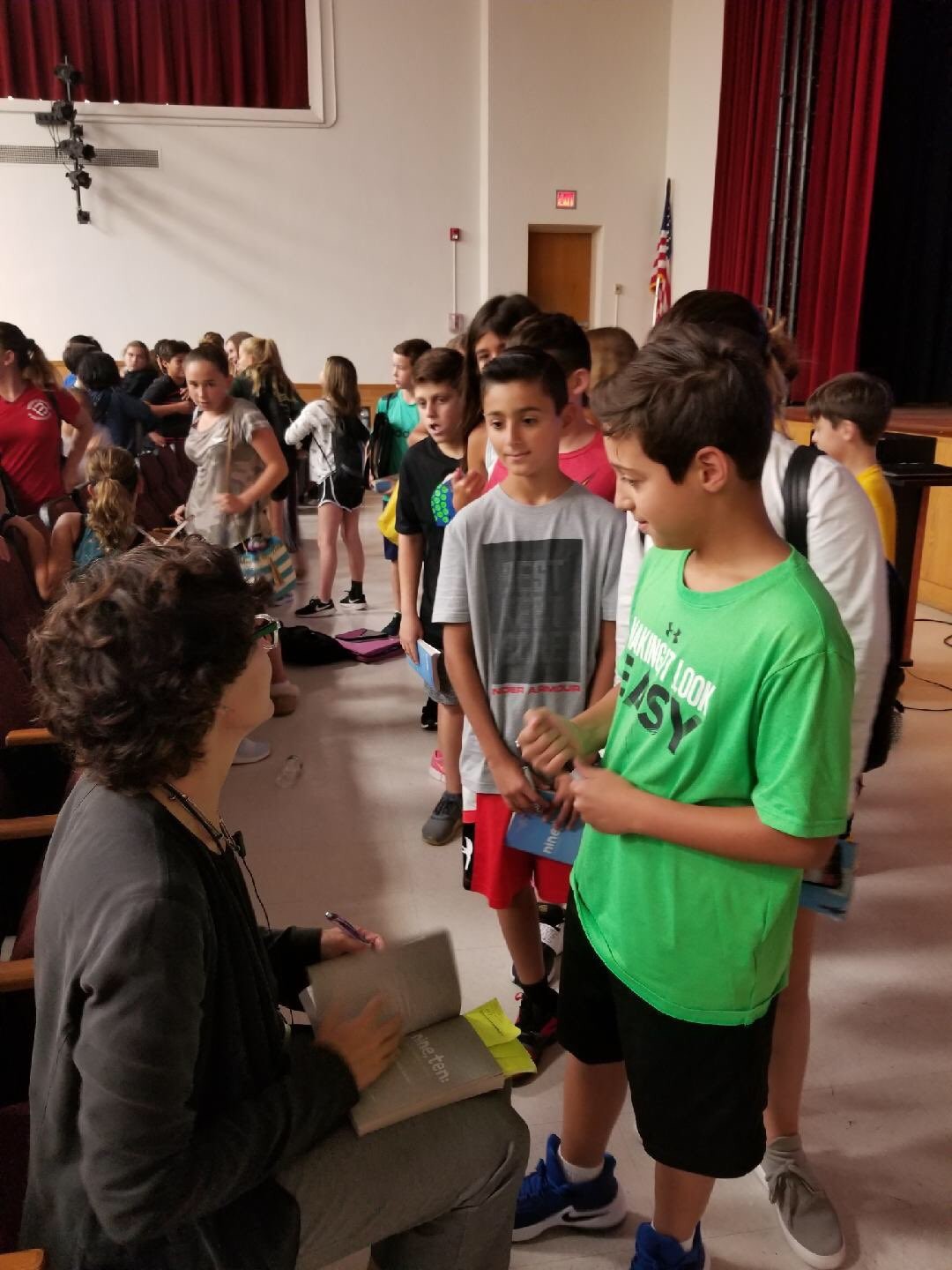Authors bring 9/11 to life for Bellmore-Merrick students
Two books on the Sept. 11, 2001, terrorist attacks — Nora Raleigh Baskin’s “Nine, Ten: A September 11 Story” and Gae Polisner’s “The Memory of Things” — offer young readers a glimpse into that day, before they were born.
On Sept. 14, Baskin visited Merrick Avenue Middle School, while Polisner visited Calhoun High School to speak to students on the importance of that day.
The two authors said they tried to create protagonists relatable to young readers, allowing them to picture life before the attacks and the seismic national changes afterward.
Children often learn about the event in school through textbooks and lessons, but for those who were alive, it was a date that will not be forgotten. Baskin compared it to Nov. 22, 1963.
“Ask anyone who was alive at the time,” she told the auditorium of seventh-graders, “and they will remember where they were when they learned that John F. Kennedy had been killed.”
People’s experiences of the two events, however, were drastically different. By the time most Americans learned of Kennedy’s death, the shooting had happened, Baskin said. On Sept. 11, however, people watched the attacks unfold in real time on TV.
Baskin’s book follows four children on Sept. 10, 2001, but does not focus on the attacks the next day. Instead, the story cuts off when the towers are hit and jumps to a year later.
“The kids start off dealing with normal, everyday things,” she said. “One is starting to get self-conscious, and lost his dad, one moved and is starting a new school. In the last few pages, it jumps to a year later and shows how much has changed.”
One character, Naheed Mohamadi, suffers the xenophobia and misinformation that occurred after the attack. Mohamadi is an American-Iraqi Muslim, who was never bullied or treated differently before the event. After, though, she is the subject of strange glances and bullying from peers in her school because of her hijab.
“On that day, people showed incredible camaraderie, but eventually fear set in,” Baskin said. “A lot of young people and kids assumed that Iraqis attacked that day, or they didn’t know the difference. That misinformation leads to racism and dangerous violence, the effects of which are still happening today.”
In “The Memory of Things,” Polisner writes from the perspective of Kyle, who is evacuating the city via the Brooklyn Bridge when he sees a girl covered in ash trying to jump off. He brings the girl home and learns that she has amnesia, and helps her to piece together the past. Kyle comes to realize that his life and the world around him have changed forever in the aftermath.
“While the girl is not the main character, she is a catalyst for learning about this uniquely American tragedy,” Polisner said. “People put aside their differences on that day. You could feel the human connection of people helping each other. It’s a reminder that we need to be kind to one another.”
For both Baskin and Polisner, it is that recognition of the tragedy and the world changes it brought about that are important for young readers to understand.
“I’ve known teachers and adults who were uncomfortable teaching about it,” Baskin said. “But it’s important for kids to point out the dangerous miscommunication and overall impact. Misinformation creates bigotry, and bigotry creates violence.”
“For these kids, it was like what World War II was for me,” Polisner said. “It’s ancient history. Their entire lives have been affected, and it’s important to emphasize that fear breeds anger and hate.”
After their presentations, the two authors took questions from the students, with one question coming up in both presentations — How did Sept. 11 impact you personally?
“It changed everything. It changed who I am,” Polisner said. “It affected how I wrote the book. I said to myself, ‘I don’t have to tell the kids what happened. I can show them.’”
“Everyone in the United States experienced some form of trauma,” Baskin said. “I struggled with letting myself feel the weight of the situation after others lost so much more. It made me want to write about how the world changed, not the losses that occurred.”
“We hope students learned about compassion, respect and enduring strength in the face of tragedy,” said Adeline Atkins, the English chairwoman at Merrick Avenue Middle School.
The spirit of remembrance continued throughout the week in the district.
“I hope that this date will always be a reminder of the strength and resilience of Americans in the days immediately following Sept. 11, 2001, and the importance of volunteerism and giving service to your community,” wrote Calhoun Principal Nicole Hollings in an email to parents and guardians. “Even the smallest acts of service and the simplest acts of kindness are a way to honor those lost and reclaim the spirit of unity that followed Sept. 11, 2001.”
Through their English classes, students in all six Central District buildings collected toiletry items to be donated to homeless veterans.
“We thank our local first responders for their dedication to protecting our community,” said John F. Kennedy Principal Gerard Owenburg. “We also remember the many Americans who have served and are currently serving in our nation’s military, many of whom enlisted as a response to the 9/11 attacks.”
Schools also observed a moment of silence on Sept. 12, as they were closed in observance of Rosh Hashana on Sept. 11. In buildings, students transitioned betwen periods in silence as well.
“This allowed everyone to reflect and pay respect to those lost on Sept. 11,” said Mepham High School Principal Eric Gómez.

 39.0°,
Fair
39.0°,
Fair 





